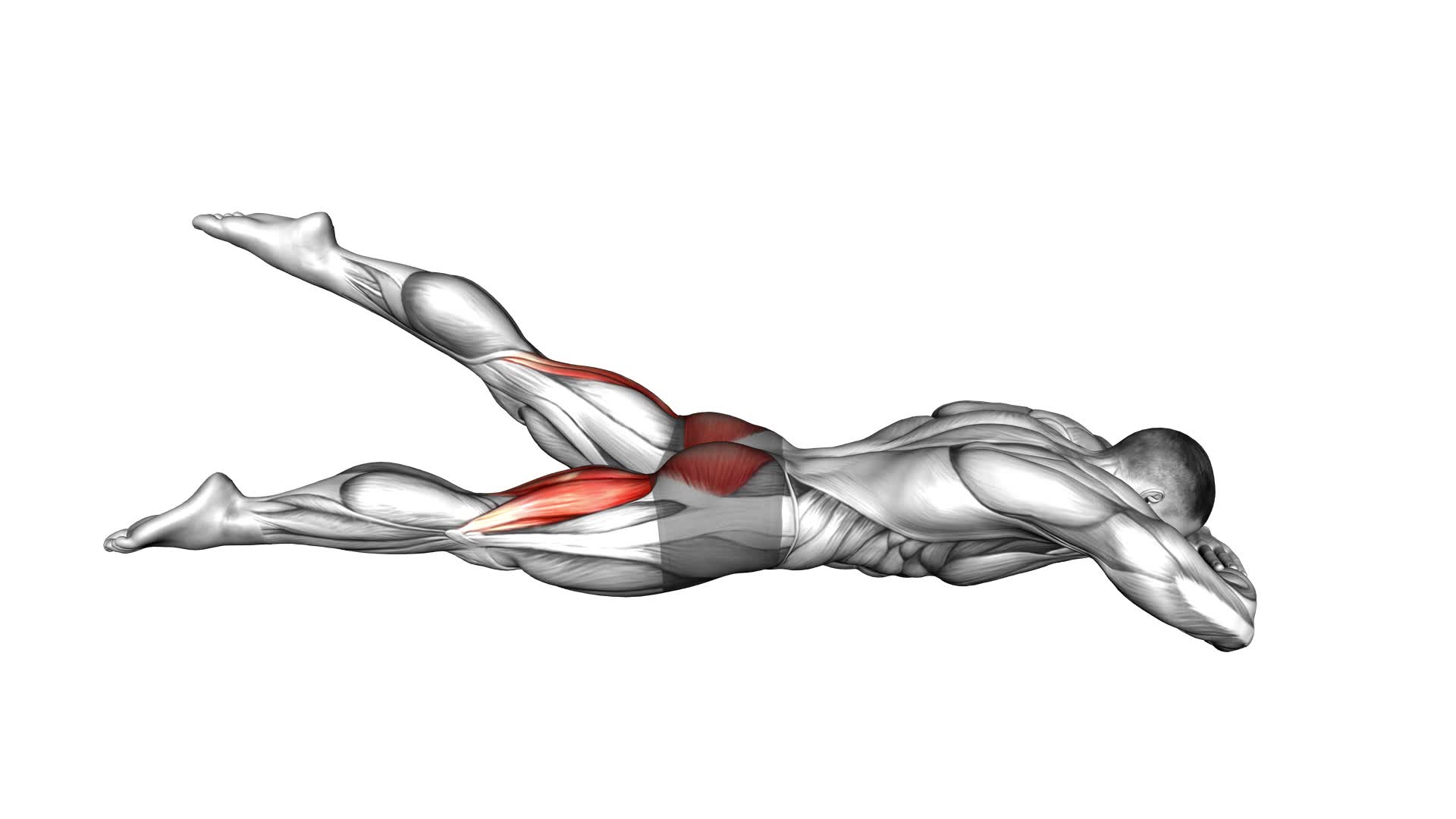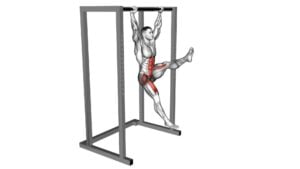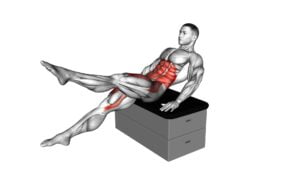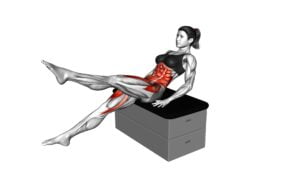Lying Alternate Flutter Kick (male) – Video Exercise Guide & Tips

Looking to strengthen your core and improve your leg strength? Look no further than the lying alternate flutter kick exercise.
Watch This Exercise Video
This video exercise guide and tips will show you the proper technique and form to get the most out of this exercise.
Learn common mistakes to avoid, variations to challenge yourself, and valuable tips for maximizing your results.
Get ready to take your fitness to the next level with this effective and efficient workout.
Key Takeaways
- Lying Alternate Flutter Kicks target different muscle groups, including the abdominal muscles, hip flexors, and quadriceps.
- This exercise helps to strengthen the abdominal muscles, hip flexors, and quadriceps, while also improving flexibility and stability in the lower back.
- Lying Alternate Flutter Kicks can increase muscular endurance and are suitable for both beginners and experienced individuals.
- It is important to maintain proper technique and form, including engaging the core muscles, avoiding common mistakes like arching the back or lifting the head, and keeping the legs straight and parallel to the ground.
Benefits of Lying Alternate Flutter Kicks
Discover the numerous benefits you can achieve by incorporating lying alternate flutter kicks into your workout routine.
Lying alternate flutter kicks offer a variety of variations that target different muscle groups and enhance overall fitness. By engaging your core, hips, and lower body, flutter kicks help strengthen your abdominal muscles, hip flexors, and quadriceps. This exercise also improves flexibility and stability in your lower back and increases muscular endurance.
To incorporate flutter kicks into a full-body workout routine, start by lying flat on your back with your legs extended. Place your hands underneath your glutes for support. Lift one leg a few inches off the ground while keeping the other leg straight and close to the floor. Alternate between legs in a scissor-like motion, keeping your movements controlled and engaging your core throughout. You can also vary the intensity by adjusting the speed and range of motion.
Including lying alternate flutter kicks in your workout routine not only targets specific muscles but also enhances overall stability and coordination. This exercise can be easily modified to suit your fitness level, making it a versatile option for beginners and experienced individuals alike.
Proper Technique and Form
To perform lying alternate flutter kicks properly, you should start by lying flat on your back with your legs extended and your hands underneath your glutes for support. This position helps to stabilize your lower back and allows you to focus on engaging your core muscles.
Once you're in the starting position, begin the exercise by lifting one leg off the ground while keeping the other leg extended and close to the floor. Alternate between legs in a scissor-like motion, making sure to keep your abs engaged and your lower back pressed firmly against the ground.
To maintain proper technique and form, avoid common mistakes such as lifting your head or shoulders off the ground, which can strain your neck and upper back. Also, be mindful of not arching your lower back or letting your legs drop too low, as this can put unnecessary pressure on your spine.
To incorporate lying alternate flutter kicks into your workout, try performing three sets of 10 to 12 repetitions. Remember to focus on proper form and engage your core muscles throughout the exercise. As you become more comfortable, you can increase the difficulty by adding ankle weights or extending the duration of each set.
Common Mistakes to Avoid
When performing the lying alternate flutter kick, it's important to avoid common mistakes that can hinder the effectiveness of the exercise.
One common mistake is incorrect body positioning, such as arching your back or letting your hips sink.
Another mistake to avoid is a lack of core engagement, as this can lead to less stability and decreased effectiveness.
Lastly, be mindful of maintaining proper kick technique, as using incorrect form can diminish the benefits of the exercise.
Incorrect Body Positioning
Avoid common mistakes in body positioning by keeping your legs straight and parallel to the ground during the lying alternate flutter kick exercise. Improper alignment can lead to decreased effectiveness and potential injury.
Ensure that your body remains in a straight line from head to toe, with your core engaged and your lower back pressed into the ground. This will help you maintain stability and maximize the benefits of the exercise.
Additionally, be mindful of your breathing technique. Breathe deeply and rhythmically, inhaling through your nose and exhaling through your mouth. This will provide oxygen to your muscles and help you maintain proper form throughout the exercise.
Lack of Core Engagement
Ensure proper core engagement to avoid common mistakes in the lying alternate flutter kick exercise. Core strength is crucial for overall fitness as it provides stability and support for the spine, pelvis, and shoulders. When your core is weak or not engaged during workouts, it can lead to a lack of control and potential injury.
To improve core engagement, focus on exercises that target the abdominal muscles, such as planks and Russian twists. Additionally, concentrate on maintaining good posture and alignment during the lying alternate flutter kick. Keep your lower back pressed firmly against the floor and draw your belly button towards your spine to activate your core.
Improper Kick Technique
To improve your kick technique and avoid common mistakes, focus on maintaining a fluid and controlled motion throughout the lying alternate flutter kick exercise.
One of the most common errors is allowing your legs to sink too low, which can put strain on your lower back and decrease the effectiveness of the exercise. To avoid this, keep your legs lifted just slightly above the surface of the ground.
Another mistake to avoid is bending your knees too much, as this can reduce the engagement of your abdominal muscles. Instead, aim to keep your legs straight and extend them fully with each kick.
If you find it difficult to maintain proper form, you can modify the exercise by performing smaller kicks or using a floatation device to support your legs.
Variations and Progressions
Now let's talk about some advanced progressions for the lying alternate flutter kick exercise.
These variations will challenge your muscles in different ways and help you take your workout to the next level.
Advanced Progressions for Flutter Kick
To advance your flutter kick, increase the difficulty by incorporating variations and progressions. Here are some advanced variations to help you improve your technique:
- Weighted Flutter Kick: Add ankle weights or hold a dumbbell between your feet to increase resistance and build strength in your legs.
- Scissor Kick: Perform a scissor-like motion with your legs, crossing one leg over the other and then switching. This challenges your coordination and engages different muscle groups.
- Vertical Flutter Kick: Perform the flutter kick while treading water in a vertical position. This variation increases the challenge by adding the element of buoyancy.
- Inverted Flutter Kick: Perform the flutter kick while lying on your back with your legs elevated. This variation engages your core muscles and challenges your balance.
Incorporating these advanced variations into your flutter kick routine will take your swimming skills to the next level and help you achieve greater strength and endurance in the water.
Benefits of Variation Exercises
By incorporating these advanced variations into your flutter kick routine, you can experience the numerous benefits of variation exercises, such as increased strength, improved coordination, and enhanced core engagement.
Progression techniques in exercise routines help to challenge your muscles in new ways, leading to increased strength and muscle activation. By gradually increasing the difficulty of the exercises, you can continue to push your limits and see improvements in your overall fitness level.
Variation exercises also improve coordination by requiring your body to adapt to different movements and positions. This helps to enhance your body's ability to move efficiently and effectively.
Additionally, by engaging your core muscles during variation exercises, you can strengthen your abdominal muscles and improve stability throughout your body.
Incorporating these variations into your flutter kick routine can provide a well-rounded workout that targets multiple muscle groups and improves overall fitness.
Tips for Maximizing Results
Achieve optimal results by incorporating these tips into your Lying Alternate Flutter Kick exercise routine.
- Vary the speed: To maximize endurance and challenge your muscles, alternate between slow and fast flutter kicks during your workout. This will help improve your cardiovascular fitness and build strength in your lower body.
- Engage your core: To increase the intensity of the exercise, focus on engaging your core muscles throughout the movement. This won't only target your abs but also improve stability and balance.
- Maintain proper form: It's essential to keep your legs straight and toes pointed during the flutter kicks. Avoid bending your knees or arching your back, as this can lead to strain and reduce the effectiveness of the exercise.
- Gradually increase reps: Start with a comfortable number of repetitions and gradually increase them over time. This progressive overload will help you challenge your muscles and continue making progress.
By implementing these tips, you can maximize the benefits of the Lying Alternate Flutter Kick exercise. Remember to listen to your body, take breaks when needed, and stay consistent with your workout routine.
Happy kicking!
Sample Workout Routine
To create an effective workout routine incorporating the Lying Alternate Flutter Kick exercise, start by incorporating these tips into your routine for optimal results.
Before starting your workout, it's important to warm up your body. Effective warm-up exercises include jogging or jumping jacks to get your heart rate up, and dynamic stretches like leg swings and arm circles to loosen up your muscles.
Once you're warmed up, you can begin your workout with the Lying Alternate Flutter Kick exercise. Lie flat on your back with your arms by your sides and your legs extended. Lift one leg a few inches off the ground while keeping the other leg straight and close to the ground. Switch legs in a fluttering motion, making sure to engage your core muscles as you kick.
To make the workout more challenging, you can modify the exercise by adding ankle weights or holding a medicine ball between your feet. This will increase the resistance and provide a greater challenge for your muscles. Remember to maintain proper form and breathe throughout the exercise.
Incorporating the Lying Alternate Flutter Kick exercise into your workout routine, along with other targeted exercises for different muscle groups, will help you build strength and improve your overall fitness level.
Frequently Asked Questions
How Many Calories Can I Burn by Doing Lying Alternate Flutter Kicks?
By doing lying alternate flutter kicks, you can burn calories and engage your muscles. This exercise targets your core, hip flexors, and lower abs, helping to strengthen and tone those areas.
The number of calories burned during this exercise can vary depending on factors such as your weight, intensity, and duration. Incorporating lying alternate flutter kicks into your workout routine can be an effective way to burn calories and work your muscles.
Can Lying Alternate Flutter Kicks Help in Improving Flexibility?
Lying alternate flutter kicks can definitely help in improving flexibility. By engaging your core muscles and increasing lower body endurance, this exercise allows you to stretch and strengthen your leg muscles.
The rhythmic movement of the flutter kicks helps to lengthen and elongate the muscles, promoting greater flexibility over time.
Incorporating this exercise into your routine can be a beneficial addition to your flexibility training.
Is It Safe to Perform Lying Alternate Flutter Kicks if I Have Lower Back Pain?
To avoid further lower back pain while performing lying alternate flutter kicks, it's important to maintain proper form. Make sure to engage your core muscles and keep your lower back flat against the ground. Avoid any excessive arching or straining of the back.
If you have lower back pain, it may be safer to opt for alternative exercises that put less stress on the back, such as leg lifts or bridges.
How Long Should I Rest Between Sets of Lying Alternate Flutter Kicks?
To ensure you get the most out of your lying alternate flutter kicks, it's important to pay attention to rest duration between sets. Giving your muscles enough time to recover is key for proper form and preventing injury. Resting for about 30-60 seconds between sets is generally recommended.
But remember, listen to your body and adjust as needed. Maintaining good form throughout the exercise is crucial for maximizing results and minimizing strain on your lower back.
Can Lying Alternate Flutter Kicks Be Incorporated Into a HIIT (High-Intensity Interval Training) Workout?
Yes, lying alternate flutter kicks can definitely be incorporated into a HIIT workout. They're a great exercise for targeting your core muscles and increasing your heart rate.
To make your HIIT workout more effective, you can combine the lying alternate flutter kicks with other exercises like burpees, mountain climbers, or plank jacks.
Just make sure to maintain proper form and technique during the kicks to avoid strain or injury.
Conclusion
In conclusion, lying alternate flutter kicks are a great exercise for strengthening the core and improving lower body strength. By following proper technique and form, avoiding common mistakes, and incorporating variations and progressions, you can maximize the results of this exercise.
Remember to always listen to your body and adjust the intensity as needed. Incorporating lying alternate flutter kicks into your workout routine can help you achieve your fitness goals.

Author
Years ago, the spark of my life’s passion ignited in my mind the moment I stepped into the local gym for the first time. The inaugural bead of perspiration, the initial endeavor, the very first surge of endorphins, and a sense of pride that washed over me post-workout marked the beginning of my deep-seated interest in strength sports, fitness, and sports nutrition. This very curiosity blossomed rapidly into a profound fascination, propelling me to earn a Master’s degree in Physical Education from the Academy of Physical Education in Krakow, followed by a Sports Manager diploma from the Jagiellonian University. My journey of growth led me to gain more specialized qualifications, such as being a certified personal trainer with a focus on sports dietetics, a lifeguard, and an instructor for wellness and corrective gymnastics. Theoretical knowledge paired seamlessly with practical experience, reinforcing my belief that the transformation of individuals under my guidance was also a reflection of my personal growth. This belief holds true even today. Each day, I strive to push the boundaries and explore new realms. These realms gently elevate me to greater heights. The unique combination of passion for my field and the continuous quest for growth fuels my drive to break new ground.







